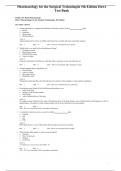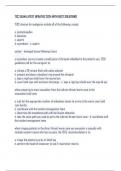1 Pharmacology for the Surgical Technologist 5th Edition Howe Test Bank Chapter 01: Basic Pharmacology Howe: Pharmacology for the Surgical Technologist, 5th Edition MULTIPLE CHOICE 1. A drug that binds to a receptor and stimulates its function is said to be a(n) drug. a. agonist b. antagonist c. idiosyncratic d. pharmacokinetic ANS: A Agonist drugs bind to or have an affinity (attraction) for a receptor and cause a particular response. DIF: 1 REF: 14 TOP: AST Core Curriculum X:B:1:b, agonist 2. Which factor is not used for the classification of drugs? a. Therapeutic action b. Physiological action c. Affected body system d. Source of origin ANS: D Drugs are classified by what they do, what they affect, what they are not, and what they are. DIF: 1 REF: 4 TOP: AST Core Curriculum X:B:2, therapeutic actio ns 3. An anticoagulant drug is classified by its a. chemical type. b. source of origin. c. physiologic action. d. therapeutic action. ANS: D Therapeutic action describes what the drug does for a patient; in this example, it works against coagulation. DIF: 1 REF: 4 TOP: AST Core Curriculum X:B:2:a, indications 4. Prescriptions must include all of the following information except a. name of the drug. b. patient’s social security number. c. drug dosage. d. route of administration of the drug. ANS: B Prescriptions must include the date, name of the patient, name of the drug, dosage, route of administration, and frequency or time of administration. The patient’s social security number will be in the chart but not on a prescription. DIF: 1 REF: 5 TOP: AST Core Curriculum XI:B:2, prescription medications 5. An order for a drug to be given as needed is called a order. a. standing b. oral c. stat d. PRN ANS: D PRN stands for pro re nata, which means that the drug may be given as needed. DIF: 1 REF: 5 TOP: AST Core Curriculum XI:D:3:d, PRN 6. What does the abbreviation sos mean on a prescription? a. One half b. Once, if necessary c. Without d. As desired ANS: B sos means once, if necessary (see Table 1.3). DIF: 1 REF: 5 TOP: AST Core Curriculum XI:B:2, prescription medications 2 7. How is an order for a drug to be taken every 4 hours indicated on a prescription? a. q4h b. qid c. qod d. qs ANS: A The q means every ; the actual number of hours is inserted before the h, which means hours (see Table 1.4). DIF: 3 REF: 7 TOP: AST Core Curriculum XI:B:2, prescription medications 8. How is an order for a drug to be given three times a day indicated on a prescription? a. q3h b. hs c. qh d. tid ANS: D tid means three times a day (see Table 1.4). DIF: 1 REF: 7 TOP: AST Core Curriculum XI:B:2, prescription medications 9. Which form of drug preparation tends to act more quickly? a. Solid b. Semisolid c. Liquid d. Gas ANS: D Absorption of drugs given by inhalation is rapid, especially gases such as inhalation anesthetics, because of the huge numbers of capillaries in the alveoli of the lungs. DIF: 2 REF: 7 TOP: AST Core Curriculum XI:G:1, gas 10. Which abbreviation indicates an ointment form of a given drug? a. gtts b. ung c. susp d. soln ANS: B ung means ointment (see Table 1.5). DIF: 1 REF: 7 TOP: AST Core Curriculum XI:G:4, semisolid 11. Which abbreviation indicates that a drug is to be given orally? a. IM b. PO c. IV d. SC ANS: B PO means per os or by mouth. DIF: 1 REF: 8 TOP: AST Core Curriculum XI:H:4, PO 12. How is a medication administered by any route except the mouth? a. Systemically b. Sublingually c. Parenterally d. Subcutaneously ANS: C The term parenteral indicates any route other than the digestive tract. DIF: 3 REF: 9 TOP: AST Core Curriculum XI:H:1, injection/parenteral 13. is the study of the four basic processes of absorption, distribution, metabolism, and excretion in response to drugs. a. Pharmacokinetics b. Pharmacodynamics c. Biotransformation d. Sympathomimetics ANS: A The study of pharmacokinetics focuses on how the body processes drugs. DIF: 1 REF: 11 TOP: AST Core Curriculum X:A:2, pharmacokinetics 3 14. Distribution of drugs within the body is carried out through which body system? a. Respiratory b. Circulatory c. Integumentary d. Urinary ANS: B Once a drug has been absorbed into the bloodstream, it is transported throughout the body by the circulatory system. Drug molecules eventually diffuse out of the bloodstream to the site of action in the process called distribution . DIF: 2 REF: 12 TOP: AST Core Curriculum X:A:2:b, distribution 15. The time between the administration of a drug and the first appearance of its effects is called a. peak effect. b. onset. c. duration. d. reaction time. ANS: B The time between the administration of a drug and the first appearance of effects is called the onset . DIF: 1 REF: 15 TOP: AST Core Curriculum X:A:3:a, onset 16. Which group of drugs is known as receptor blockers? a. Antagonists b. Agonists c. Antipyretics d. Analgesics ANS: A Drugs that bind to a receptor and prevent a response are called antagonists (Fig. 1.17). Antagonists are also called receptor blockers . DIF: 2 REF: 14 TOP: AST Core Curriculum X:B:1:c, antagonist 17. An expected but unintended effect of a drug is termed a(n) effect. a. idiosyncra tic b. adverse c. synergic d. side ANS: D A side effect is a predictable but unintended effect of a drug. DIF: 1 REF: 15 TOP: AST Core Curriculum X:B:3:a, side effects 18. Malignant hyperthermia is a(n) effect to certain drugs. a. idiosyncratic b. adverse c. local d. side ANS: A Most idiosyncratic drug reactions are thought to occur in people with some genetic abnormality, causing either an excessive or an inadequate response to a drug. For example, malignant hyperthermia (see Chapter 16) is a life-threatening response to certain drugs and is attributable to a genetic defect. DIF: 3 REF: 15 TOP: AST Core Curriculum X:B:3:b, adverse effects 19. Which drug form is used the least in the surgical department? a. Semisolid b. Solid c. Liquid d. Gas ANS: B Solids such as capsules and tablets, are rarely used in surgery, because oral administration is required. DIF: 2 REF: 7 TOP: AST Core Curriculum XI:G:3, solid 20. When a drug travels from the site of administration into the bloodstream, it is called a. absorption. b. distribution. c. metabolism. d. excretion. ANS: A Absorption is the process by which a drug is taken into the body and moves from the site of administration into the blood. DIF: 2 REF: 11 TOP: AST Core Curriculum X:A:2:a, absorption 4 21. Drugs are chemically altered via a process called metabolism in the a. lungs. b. colon. c. kidney. d. liver. ANS: D The chemical composition of a drug is changed in the liver by a process called metabolism or biotransformation . DIF: 1 REF: 12 TOP: AST Core Curriculum X:A:2:c, metabolism 22. Most drugs are excreted and eliminated by the a. lungs b. colon c. kidney d. liver ANS: C Some drug molecules are eliminated in the bile, feces, or skin, but most unchanged drugs and metabolites are excreted by the kidneys and eliminated in urine (Fig. 1.16). DIF: 1 REF: 14 TOP: AST Core Curriculum X:A:2:d, excretion 23. A drug that enhances the effect of another drug is called a(n) a. agonist. b. synergist. c. antagonist. d. receptor blocker. ANS: B A drug that enhances the effect of another drug is called a synergist . DIF: 1 REF: 14 TOP: AST Core Curriculum X:B:1:a, synergist 24. Which type of drug binds to receptor site proteins and then inhibits a response? a. Agonist b. Synergist c. Antagonist d. Electrolyte ANS: C Drugs that bind to a receptor and prevent a response are called antagonists . DIF: 2 REF: 14 TOP: AST Core Curriculum X:B:1:c, antagonist 25. What is the considered the purpose for giving a medication? a. Duration b. Biotransformation c. Indication d. Distribution ANS: C The reason or purpose for giving a medication is called an indication. DIF: 1 REF: 15 TOP: AST Core Curriculum X:B:2:a, indications 26. The abbreviation bid represents a. twice a day. b. three times a day. c. four times a day. d. immediately. ANS: A bid means twice a day . DIF: 1 REF: 7 TOP: AST Core Curriculum XI:B:2, prescription medications 27. The abbreviation NPO represents a. discontinue. b. immediately. c. keep vein open. d. nothing by mouth. ANS: D NPO means nothing by mouth . DIF: 1 REF: 7 TOP: AST Core Curriculum XI:B:2, prescription medications






